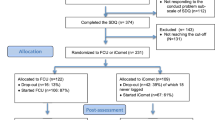Abstract
Parents of 43 conduct- problem children, aged 3– 8 years, were randomly assigned to one of two treatments: an individually self- administered video-tape modeling treatment (IVM) and IVM treatment plus therapist consultation (IVMC). Randomization also included a waiting- list control group (CON). Compared with the control group, both treatment groups of mothers reported significantly fewer child behavior problems, reduced stress levels, and less use of spanking. Home visit data indicated that both treatment groups exhibited significant behavioral changes. There were relatively few differences between the two treatment conditions. However, the IVMC children were significantly less deviant than the IVM children, suggesting that the IVMC (with therapist consultation) treatment was superior to self- administered treatment with no therapist involvement. The added benefits of therapist involvement are discussed.
Similar content being viewed by others
References
Abidin, R. R. (1983).Parenting Stress Index-Manual. Charlottesville, VA: Pediatric Psychology Press.
Achenbach, T. M., & Edelbrock, C. S. (1983).Manual for the Child Behavior Checklist and Revised Child Behavior Profile. Burlington, VT: University Associates in Psychiatry.
Boggs, S. R., Eyberg, S., & Reynolds, L. A. (in press). Concurrent validity of the Eyberg Child Behavior Inventory.Journal of Clinical Child Psychology.
Chamberlain, P. (1980).A parent daily report measure. Unpublished doctoral dissertation, University of Oregon.
Chamberlain, P., & Reid, J. B. (1987). Parent observation and report of child symptoms.Behavioral Assessment, 9, 97–109.
Eyberg, S. M., & Ross, A. W. (1978). Assessment of child behavior problems: The validation of a new inventory.Journal of Clinical Psychology, 16, 113–116.
Forehand, R. L., King, H. E., Reid, S., & Yoder, P. (1975). Mother-child interactions: Comparison of a noncompliant clinic group and a nonclinic group.Behavior Research and Therapy, 13, 79–84.
Forehand, R. L., & McMahon, R. J. (1981).Helping the noncompliant child: A clinician's guide to parent training. New York: Guilford Press.
Hanf, C, & Kling, F. (1973).Facilitating parent-child interaction: A two-stage training model. Unpublished manuscript, University of Oregon Medical School, Eugene.
Hollingshead, A. B., & Redlich, F. C. (1958).Social class and mental illness. New York: Wiley.
Lobitz, G. K., & Johnson, S. M. (1975). Normal versus deviant children: A multi-method comparison.Journal of Abnormal Child Psychology, 3, 353–374.
Patterson, G. R. (1975).Families: Applications of Social Learning to Family Life. Champaign, IL: Research Press.
Robinson, E. A., & Eyberg, S. M. (1981). The dyadic parent-child interaction coding system: Standardization and validation.Journal of Consulting and Clinical Psychology, 49, 245–250.
Robinson, E. A., Eyberg, S. M., & Ross, A. W. (1980). The standardization of an inventory of child conduct problem behaviors.Journal of Clinical Child Psychology, 9, 22–28.
Webster-Stratton, C. (1985). Mother perceptions and mother-child interactions: Comparison of a clinic-referred and a nonclinic group.Journal of Clinical Child Psychology, 14, 334–339.
Webster-Stratton, C. (1987).Parents and children: A 10 program videotape parent training series with manuals. Eugene, OR: Castalia Press.
Webster-Stratton, C, Kolpacoff, M., & Hollinsworth, T. (1988). Self-administered videotape therapy for families with conduct-problem children: Comparison with two cost-effective treatments and a control group.Journal of Consulting and Clinical Psychology, 56, 458–566.
Author information
Authors and Affiliations
Additional information
This research was supported by NIH Institute of Nursing Grant 2 R0I NR01 075-05. Special appreciation goes to Christine Howard for her careful preparation of the manuscript and to Ada Spitzer for her qualitative analysis of the consultations.
Rights and permissions
About this article
Cite this article
Webster-Stratton, C. Enhancing the effectiveness of self-administered videotape parent training for families with conduct-problem children. J Abnorm Child Psychol 18, 479–492 (1990). https://doi.org/10.1007/BF00911103
Revised:
Issue Date:
DOI: https://doi.org/10.1007/BF00911103




